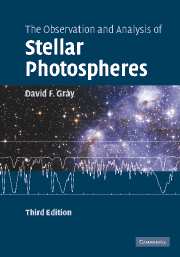Book contents
- Frontmatter
- Contents
- Preface to the first edition
- Preface to the second edition
- Preface to the third edition
- 1 Background
- 2 Fourier transforms
- 3 Spectroscopic tools
- 4 Light detectors
- 5 Radiation terms and definitions
- 6 The black body and its radiation
- 7 Radiative and convective energy transport
- 8 The continuous absorption coefficient
- 9 The model photosphere
- 10 The measurement of stellar continua
- 11 The line absorption coefficient
- 12 The measurement of spectral lines
- 13 The behavior of spectral lines
- 14 The measurement of stellar radii and temperatures
- 15 The measurement of photospheric pressure
- 16 Chemical analysis
- 17 Velocity fields in stellar photospheres
- 18 Stellar rotation
- Appendix A A table of useful constants
- Appendix B Physical parameters of stars
- Appendix C A fast Fourier transform Fortran program
- Appendix D Atomic data
- Appendix E The strongest lines in the solar spectrum
- Appendix F Computation of random errors
- Index
- References
4 - Light detectors
Published online by Cambridge University Press: 05 March 2015
- Frontmatter
- Contents
- Preface to the first edition
- Preface to the second edition
- Preface to the third edition
- 1 Background
- 2 Fourier transforms
- 3 Spectroscopic tools
- 4 Light detectors
- 5 Radiation terms and definitions
- 6 The black body and its radiation
- 7 Radiative and convective energy transport
- 8 The continuous absorption coefficient
- 9 The model photosphere
- 10 The measurement of stellar continua
- 11 The line absorption coefficient
- 12 The measurement of spectral lines
- 13 The behavior of spectral lines
- 14 The measurement of stellar radii and temperatures
- 15 The measurement of photospheric pressure
- 16 Chemical analysis
- 17 Velocity fields in stellar photospheres
- 18 Stellar rotation
- Appendix A A table of useful constants
- Appendix B Physical parameters of stars
- Appendix C A fast Fourier transform Fortran program
- Appendix D Atomic data
- Appendix E The strongest lines in the solar spectrum
- Appendix F Computation of random errors
- Index
- References
Summary
Light detectors have the important job of converting stellar photons into recordable signals. Remarkable and wonderful developments in detectors have occurred over the last two decades, resulting in dramatic increases in speed and improved signal-to-noise ratios. Most notable for stellar-photospheric studies are the silicon array detectors such as the charge-coupled devices (CCDs) and self-scanned arrays. To make quality observations of stellar spectra, the observer must be cognizant of the basic detector parameters: quantum efficiency, spectral response, linearity, noise, and spatial resolution. These properties can be defined for any detector, and the reader can extend the concepts of this chapter to the detector of choice for the job to be done.
Detectors can be grouped into “integrating” and “pulse-counting” types. In the first class, photons are accumulated for some integration time, and then the total signal is measured. Examples are (unintensified) silicon-diode detectors and the photographic process. In the second class, electrical pulses for individual photons are recorded. Examples include photomultipliers and various kinds of electron image tubes. Integrating-silicon devices tend to be used for higher signal-to-noise ratio work and pulse-counting ones for lower signal-to-noise ratios. A high signal-to-noise ratio is needed for much of our work on stellar photospheres.
- Type
- Chapter
- Information
- The Observation and Analysis of Stellar Photospheres , pp. 89 - 106Publisher: Cambridge University PressPrint publication year: 2005



